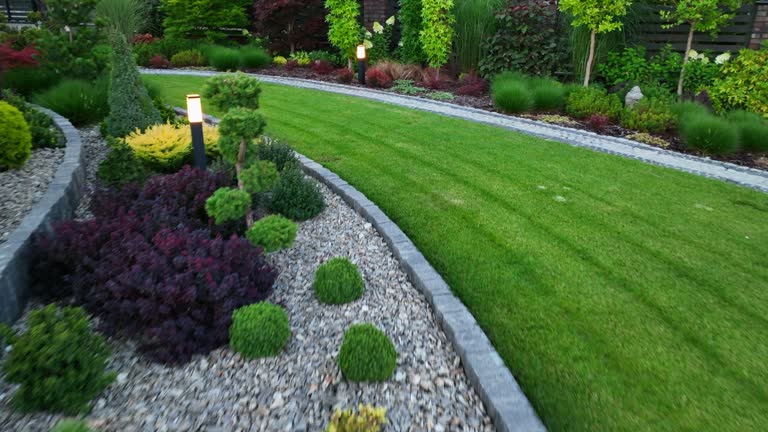Landscaping is more than just gardening trees and cutting lawns—it’s a craft that mixes nature with imagination to improve the aesthetics and usefulness of open-air spaces. Whether for private backyards or commercial properties, great arranging makes concordance between design and nature.
The Significance of Landscaping
Landscaping in Detroit MI offers numerous services past visual request. It contributes to natural well-being, decreases soil disintegration, bolsters neighborhood biological systems, and indeed increases property value. Well-designed open-air spaces, moreover, give mental unwinding, empower open-air exercises, and offer security and shade.

Elements of a Wonderful Landscape
Effective arranging is a combination of a few elements:
- Hardscape: Incorporates patios, decks, walkways, and holding walls.
- Soft cape: gardens, grass, blossoms, and trees.
- Water Highlights: Wellsprings, lakes, and little waterfalls.
- Lighting: Open-air lights not only make strides in security but, moreover, highlight key features.
- Balancing these components makes a cohesive and welcoming open-air environment.
Types of Arranging Services
Depending on your needs, there are diverse sorts of arranging services available:
- Landscape Plan—Arranging the format and choosing gardens/materials.
- Landscape Installation—Putting the plan into place.
- Landscape Support—Customary trimming, grass cutting, weeding, etc.
- Irrigation Frameworks—Introducing and overseeing sprinkler systems.
- Seasonal Cleanup—Leaf expulsion, snow clearing, spring prep.
Hiring experts for each organization guarantees high quality and long-term sustainability.
Residential vs. Commercial Landscaping
Residential arranging centers on consolation, excellence, and personalized space. It frequently incorporates gardens, patios, decks, and children-friendly areas.
Commercial arranging, on the other hand, emphasizes tidiness, openness, and solidness. Think office gardens, inn gardens, and open parks planned to handle foot activity while remaining green and inviting.
Sustainable Arranging Practices
Sustainable arranging decreases natural affect and long-term costs. Here are a few eco-friendly practices:
Native gardens require less water and adjust effortlessly to the neighborhood climate.
Mulching makes a difference in holding soil dampness and decreasing weed growth.
- Rain gardens: Capture stormwater and diminish runoff.
- Drip water system: Moderates water more productively than conventional sprinklers.
Implementing these strategies leads to more advantageous scenes and diminished maintenance.
DIY Arranging Tips for Homeowners
If you’re taking a hands-on approach, here are a few beginner-friendly tips:
- Start with an arrangement: Portray your format some time recently, you dig.
- Choose gardens shrewdly: consider sun/shade needs and water availability.
- Layer gardens: Utilize shifting statures for measurement and texture.
- Keep it low support: Select gardens that don’t require steady attention.
- Test your soil: It makes a difference in deciding what kind of gardens will thrive.
- Even a little cultivation can turn into a serene withdrawal with astute planning.
Common Arranging Botches to Avoid
Even prepared property holders can drop into these traps:
- Over gardening: Too many gardens make upkeep difficult and can overpower the space.
- Neglecting daylight designs: A few gardens won’t survive in too much or too little sun.
- Ignoring seepage: A destitute water stream can crush your yard and gardens.
- No central point: Each yard needs a central element—be it a tree, form, or water feature.
Learning from these botches can spare you time, cash, and effort.
Hiring the Right Arranging Professional
If your arranging extension is expansive or complex, enlisting a professional can make a world of difference. See for:
Experience and portfolio: Inquire for before-and-after photos.
References and audits: Word of mouth is an effective tool.
Insurance and licenses: These secure you from liability.
Clear contract: Guarantee it incorporates timelines, costs, and upkeep options.
A great landscaper will tune in to your vision and bring it to life, whereas advertising masters advise.
(FAQs)
How frequently ought I water my landscape?
It depends on your climate and garden types. On average, gardens require almost 1 inch of water per week. Early morning is the best time to water.
What is the best time of year to start landscaping?
Spring and drop are perfect for most arranging work. These seasons offer gentle temperatures and adequate precipitation for garden Installation.
How do I keep up my arranging year-round?
Regular cutting, pruning, weeding, and regular cleanups are fundamental. Consider a month-to-month upkeep plan or enlist professionals.
Can arranging increment property value?
Yes! Well-maintained landscaping can boost control requests and raise property value by up to 15%.
Are there low-maintenance alternatives for landscaping?
Absolutely. Utilize drought-tolerant gardens, introduce mulch beds, and select slow-growing bushes to diminish upkeep.
Conclusion
Professional landscaping is more than a visual upgrade—it’s a way to move forward your quality of life, bolster the environment, and make your domestic or commercial space stand out. Whether you go DIY or work with aces, keen arranging can change any space into something extraordinary.
